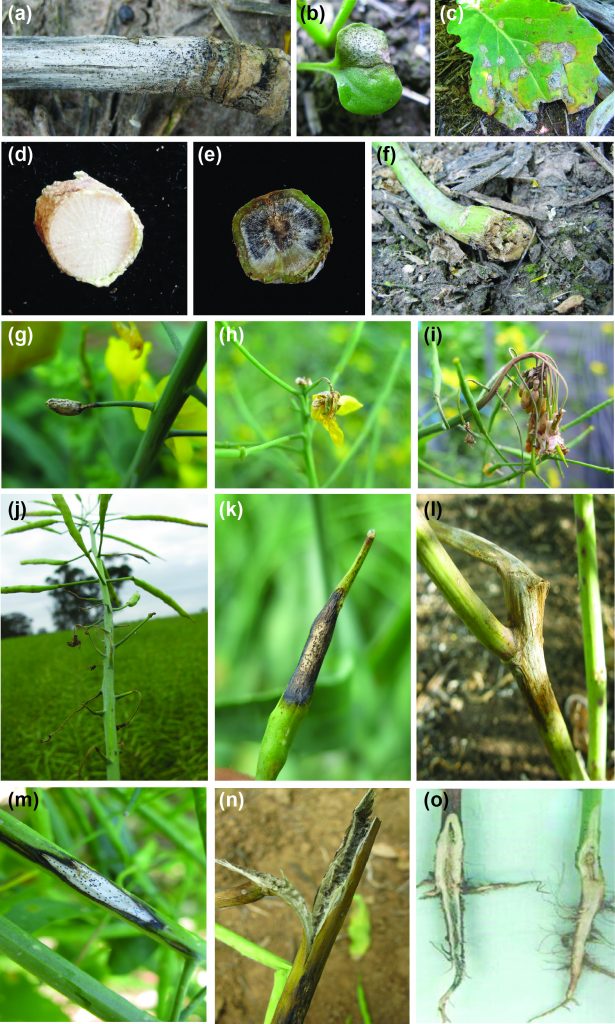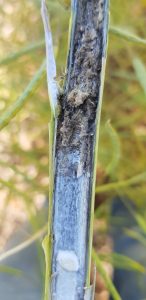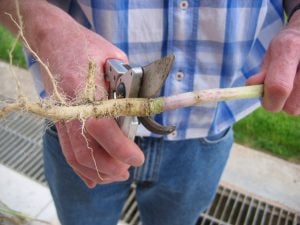Blackleg is Challenging to Control:
- Leptosphaeria maculans, the causal agent of blackleg, is a sexually reproducing pathogen that can overcome cultivar resistance genes
- Fungal spores are released from canola stubble and therefore the disease is more severe in areas of intensive canola production
- Spores are spread extensively and quickly via wind and rain splash.
Blackleg, caused by the fungus Leptosphaeria maculans, is the most serious disease of canola in Australia. Blackleg is most severe in regions of high canola intensity with moderate to high rainfall. Although not common, yield losses of 50 per cent and greater have been recorded. Where cultivar blackleg resistance has been overcome, up to 90 per cent yield loss has been recorded.
What to Look For
In the autumn and winter, rainfall triggers spore release from the fruiting bodies on stubble. Within three weeks of spores landing on canola cotyledons and young leaves, clearly visible off-white coloured lesions develop. Within the lesion, pycnidial fruiting bodies (dark coloured dots) form and then release rain-splashed spores which can cause secondary infections.
Once the lesion has formed, the fungus grows within the plant’s vascular system to the base where it causes the crown of the plant to rot resulting in a canker. Severe canker will sever the roots from the stem, whereas a less severe infection will result in internal infection of the crown restricting water and nutrient flow within the plant. When no infection is present, a clear white stem is visible.
In recent years, blackleg lesions have commonly been seen on the upper canopy of the plant, including the flowers, pods, upper stem and branches. This type of infection, referred to collectively as upper canopy infection (UCI), has become a significant yield limiting factor.
Blackleg symptoms have also been found in the plant roots; in severe cases this root infection appears to cause the entire plant to die prematurely.

Blackleg disease symptoms caused by Leptosphaeria maculans. Blackleg infested stubble
(a) covered in fruiting bodies (black dots). Typical cotyledon
(b) and leaf lesions (c) seen early in the growing season. Blackleg can infect the crown of the stem; panel (d) shows a clean stem, whilst panel (e) shows a severely infected stem which would result in yield loss. In severe cases, the stem can sever off from the roots (f). In recent years blackleg has infected the upper canopy (panels g-n). This includes infection of the flowers (g – j), which leads to abortion of pod development; direct infection of the pods (k) as well as branches (l and m) and upper stems (n). Lastly, the roots of the plant can also be infected in severe situations (o). Photos: S. Marcroft, A. Van de Wouw, S. Sprague.
Disease Cycle
Blackleg survives on canola stubble producing fruiting bodies (pseudothecia) that contain large quantities of airborne spores; capable of travelling several kilometres. However, the majority of spores only travel a short distance (less than 500m). Timing of spore release from the stubble normally occurs approximately 3 weeks after the break of the season and is therefore dependent on autumn rainfall. Higher rainfall environments therefore often have earlier seasonal spore release, longer periods of leaf wetness and consequently increased disease severity.
The main infection period for blackleg is from mid-May through to the end of July, this is because infection is a result of spore release in the presence of long periods of plant wetness. Consequently, if plants are at the seedling – vegetative stage from mid-May to the end of July there will be cotyledon and leaf infection. Early infection of cotyledons/leaves (up to the 6th leaf) give the fungus enough time to grow down the stem and cause severe crown canker. Therefore, if the crop is at the early growth stages during the infection period (spore release), protection of the cotyledons/leaves is essential for minimising crown canker.
Early sown crops that become reproductive (elongating and flowering) during the peak infection period (prior to the end of July) may also get lesions forming on the flowers and stems/branches. This infection is known as upper canopy infection.
After harvest the blackleg fungus survives on the canola stubble and undergoes sexual reproduction, ready to release spores in the following growing season.
Management
Management practices to control crown canker blackleg are the same for the root rot form of the disease as follows:
- Consult the Blackleg Management Guide on the GRDC website (www.grdc.com.au) for up to date ratings, resistance groups and management practices.
- Download BlacklegCM App on your iPad or Tablet to use the interactive model to investigate all management options for your individual paddock. The App does not work on mobile phones.
- Monitor your crop to determine yield losses.
- Choose a cultivar with adequate blackleg resistance for your region.
- Never sow your canola crop into last year’s canola stubble, ideally leave 500m distance from this year’s crop and last season’s stubble.
- Use fungicides strategically to control blackleg, economic return from fungicides is dependent on blackleg severity. If using R rated cultivars, fungicides are unlikely to provide an economic return. Generally seed treatments and fertiliser amended with fungicide are likely to give an economic return especially if your crop is sown adjacent to the previous season’s stubble. Foliar fungicides should only be used in very wet years where disease severity if unusually high, or if other management options cannot be used (e.g. sowing a lower resistance rating cultivar next to the previous season’s stubble). Use the BlacklegCM App to investigate individual fungicide application scenarios.
- If your monitoring identifies high levels of internal infection and you have grown the same cultivar for three years or more, choose a cultivar from a different resistance group.

Cutting branches to assess the number of plants with infected (black) pith as an indication of upper canopy infection (Photo: Steve Marcroft – Marcroft Grains Pathology)
Management for upper canopy blackleg infection:
- Monitor your crop in the spring for flower infection and at windrowing for stem, branch and pod infection. The monitoring will not help in the current season but will provide some guidance to crop management requirements for future seasons.
- Plan the crop flowering time. In most regions crops that commence flowering in early August will avoid most UCI symptoms. Crops that flower during June and July are more likely to be infected. Flowering time can be altered by sowing date and/or by choosing cultivars that are later flowering.
- If applying fungicide for sclerotinia control and the fungicide is registered for both Sclerotinia and blackleg, it is likely that the application for sclerotinia will also provide protection against UCI. Fungicide should be applied at 30 per cent bloom which is the current sclerotinia timing recommendation.
- Cultivars that have effective major gene resistance will not get UCI symptoms regardless of their flower commencement timing.
- The UCI BlacklegCM App is now available for phones and tablets. This app can be used to help make spray decisions for controlling UCI. However, please note that the app is being updated each year as we gain additional knowledge about this form of the disease.
- We recommend where possible, to monitor your crop at the end of the season to determine whether you did indeed have UCI (if you didn’t apply a fungicide). Whilst it won’t help with making decisions in the current year, it will help you understand your risk the following year.
Please note: This book is also available on AppleBooks



